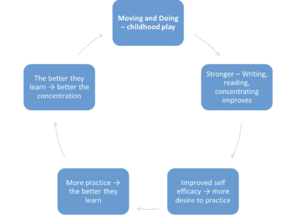The Road to Writing and Moving in Early and Middle Childhood
Top Contributors - Jess Bell, Naomi O'Reilly, Kim Jackson, Tarina van der Stockt, Wanda van Niekerk and Cindy John-Chu
Introduction[edit | edit source]
Postural control begins in the brain and ends in the hand or foot. Typically, by the age of 7 years, postural control should be consolidated and automatic and children will be “writing ready” and “sport ready”.[1] However, some children may not develop this postural control for a number of reasons, including:[1]
- They may be too floppy or bendy - i.e. they have low connective tissue tone with underlying weaknesses, even if they are sporty. This may be caused by conditions such as:
- Benign joint hypermobility syndrome
- Marfan syndrome
- Ehlers–Danlos Syndrome (EDS)
- The Beighton Scale is used to measure hypermobility[2]
- Lack of practice, which leads to muscle weakness
- An inability to concentrate on one specific activity
- A child’s temperament
- Too shy
- Too nervous
- Gives up easily
- Children who have different brain development, which affects their ability to learn from everyday experiences - i.e. children who do not learn by “doing”
Learning Through Play[edit | edit source]
As is shown in Figure 1, children typically experience by “doing” things. The more “doing”, the more learning. The more “doing”, the stronger their muscles get. Strong muscles and exercise are good for writing, reading, concentrating and exercising. Exercise is also good for happiness, health, friendships.
The Building Blocks of Learning[edit | edit source]
Early learning can be broken down into four levels:[1]
Level One - Primary Sensory Systems[edit | edit source]
- Infant
- 0 to 3 months
- Taking in sound, taste, vision, touch and smell
- This phase starts in the womb
Level Two - Sensory Motor Skills[edit | edit source]
- Baby to toddler
- 3 to 24 months
- Develop independent movement
- Gains body awareness and motor planning
Level Three - Perceptual Motor Skills[edit | edit source]
- 2 to 4 years old
- Speech and language
- Auditory and visual discrimination
- Eye hand coordination
- Purposeful activity
Level Four - Academic and Sport Readiness[edit | edit source]
- 5 to 7 years old
- Specialisation and automation
- Organised behaviour, postural control
- Self-esteem and self-control
These levels are based on the work of Ayres[3] and Stock Kranowitz.[4]
When Learning and Sport go Wrong[edit | edit source]
Some children may not be ready for sports or academic learning as early as others. These children may have the following characteristics:[1]
- Poor concentration
- Fidgeting
- Inactivity / withdrawing from playground activity / sport
- Poor pencil grip
- Low academic confidence
- Physical and muscular coping strategies:
- The strong child
- The floppy child
- Pain
Ensuring that a child engages in the cycle of doing, learning and practising can help him / her to achieve writing and sport readiness:[1]
- Encourage playful learning
- Be prepared for more teaching and more practice to help a child master a skill
- Instill “grit” through understanding
- Sitting should be comfortable
- Foot support (i.e. footstool, height adjustable chair)
- If on the floor, consider how the child is sitting - alignment, midline orientation / focus of attention, static propping or weight collapsing?
- Wobble / fidget?
- Allow lots of movement
- Do not have children sitting still for more than 20 minutes (in Grade / Year 1)
- Have movement breaks:
- Send the child out on errands
- Straighten Up UK Programme https://www.youtube.com/watch?v=Jioiv5AJtk4)
- Movement plays an important part in sitting - “a school in which movement is supported and encouraged has a positive effect on the learning ability and attentiveness of the children” (Dr Dieter Breitheckerxi) FIRA
- Incorporate “anti-gravity” creative play into daily routine.
- Practice sitting
- Build up to 20 minutes
- Incorporate a variety of positions during play - side lying, four point kneeling, kneel standing, but no “W” sitting
- A stable but dynamic base (“core”) is necessary to free up distal sections to ensure efficient and effective motor function
References[edit | edit source]
- ↑ 1.0 1.1 1.2 1.3 1.4 Prowse T. The Social, Cognitive and Emotional Development of Children - The Road to Writing and Moving Course. Physioplus, 2021.
- ↑ Simmonds J. Generalized joint hypermobility: a timely population study and proposal for Beighton cut-offs. Rheumatology (Oxford). 2017;56(11):1832-3.
- ↑ Ayres AJ. Sensory integration and the child: Understanding hidden sensory challenges. United States: Western Psychological Services, 2005.
- ↑ Stock Kranowitz C. Out of Sync Child. Available from: https://out-of-sync-child.com (accessed 4 August 2021).
- ↑ Stanford Alumni. Developing a Growth Mindset with Carol Dweck. Available from: https://www.youtube.com/watch?v=hiiEeMN7vbQ [last accessed 4/8/2021]







